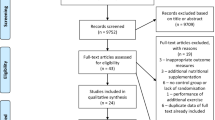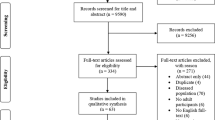Abstract
Background
The purpose of this study verify the immediate effect of whole body vibration (WBV) on quadriceps muscle strength, functional mobility and balance in elderly patients with Osteopenia and/or Osteoporosis.
Methods
This was a randomized pragmatic clinical trial with 34 elderly (32 women) randomly assigned to two groups: the experimental group (EG; n = 17) who underwent low-frequency (16 Hz) WBV and the control group (CG; n = 17) who performed the walk. Outcome measures were: quadriceps muscle strength measured by a maximal repetition test (1RM); functional mobility assessed by the Timed Up and Go (TUG) test and balance assessed by the Berg Balance Scale (BBS).
Results
In within-group interaction, a significant increase was observed in quadriceps muscle strength (EG:p = 0.047) and balance (EG: p = 0,012; CG: p = 0,007). In between-groups interaction, a significant difference was not observed. There was an increase in the muscular strength of the EG and in the balance in both groups.
Conclusion
An WBV training session was able to alter the muscular strength of the LQ and the balance of the elderly with Osteopenia and/or Osteoporosis. It is suggested, however, that future studies involving larger sample number and/or populations should be developed to analyze the short-term effects of WBV.



Similar content being viewed by others
Abbreviations
- OP:
-
Osteoporosis
- OPN:
-
Osteopenia
- WBV:
-
Whole body vibration
- CONSORT:
-
Consolidated Standards of Reporting Trials
- LACIRTEM:
-
Laboratório de Cinesioterapia e Recursos Terapêuticos Manuais
- UFPE:
-
Universidade Federal de Pernambuco
- FICF:
-
Free and Informed Consent Form
- IBM:
-
Body mass index
- EG:
-
Experimental Group
- CG:
-
Control group
- HPAQ:
-
Habitual Physical Activity Questionnaire
- 1RM:
-
One repetition maximum
- BBS:
-
Berg Balance Scale
- TUG:
-
Timed Up and Go
- SBP:
-
Systolic blood pressure
- DBP:
-
Diastolic blood pressure
- RR:
-
Respiratory rate
- HR:
-
Heart rate
- SpO 2:
-
Saturation
- MAP:
-
Mean Arterial Pressure
- SPSS:
-
Statistical Package for Social Science
- L1:
-
First lumbar vertebra
- L4:
-
Fourth lumbar vertebra
- BMD:
-
Bone mineral densitometry
- T :
-
Standard deviations
References
Lopes, IDA. Osteoporosis and aging. 2014. Master Thesis.
Brech GC, Alonso AC, Luna NM, Greve JM. Correlation of postural balance and knee muscle strength in the sit-to-stand test among women with and without postmenopausal osteoporosis. Osteoporos Int. 2013;24(7):2007–13.
Varahra A, Rodrigues IB, MacDermid JC, Bryant D, Birmingham T. Exercise to improve functional outcomes in persons with osteoporosis: a systematic review and meta-analysis. Osteoporos Int. 2018;29(2):265–86.
Caíres EL, Bezerra MC, Araújo AF, Araújo SM, Albuquerque SC, D’alva CB. Treatment of postmenopausal osteoporosis: an algorithm based on the literature for use in the public health system. Rev Bras Reumatol. 2017;57(3):254–63.
Schuiling KD, Robinia K, Nye R. Osteoporosis update. J Midwifery Womens Health. 2011;56(6):615–27.
MS, Ordinance No. 451, June 9, 2014. Clinical Protocol and Therapeutic Guidelines of Osteoporosis.
Moraes LF, Silva EN, Silva DA, Paula AP. Expenditure on the treatment of osteoporosis in the elderly in Brazil (2008-2010): analysis of the associated factors. Rev Bras Epidemiol. 2014;17(3):719–34.
Rikkonen T, Sirola J, Salovaara K, Tuppurainen M, Jurvelin JS, Honkanen R, et al. Muscle strength and body composition are clinical indicators of osteoporosis. Calcif Tissue Int. 2012 Aug 1;91(2):131–8.
Souza MP. Diagnosis and treatment of osteoporosis. Rev Bras Ortop. 2010;45(3):220–9.
Dizdar M, Irdesel JF, Dizdar OS, Topsac M. Effects of balance-coordination, strengthening, and aerobic exercises to prevent falls in postmenopausal patients with osteoporosis: a 6-month randomized parallel prospective study. J Aging Phys Act. 2018 Jan 1;26(1):41–51.
Borges DT, Macedo LB, Lins CA, Brazilian JS. Immediate effects of whole-body vibration on neuromuscular performance of quadriceps and oscillation of the center of pressure: a randomized controlled trial. Man Ther. 2016 Sep 1;25:62–8.
Bosveld R, Field-Fote EC. Single-dose effects of whole body vibration on quadriceps strength in individuals with motor-incomplete spinal cord injury. J Spinal Cord Med. 2015 Nov 1;38(6):784–91.
Schulz KF, Altman DG, Moher D. CONSORT 2010 statement: updated guidelines for reporting parallel group randomized trials. BMC Med. 2010;8(1):18.
Brandão C, Camargos BM, Zerbini CA, Plapler PG, Mendonça LM, Albergaria BH, et al. 2008 official positions of the Brazilian Society for Clinical Densitometry-SBDens. Arq Bras Endocrinol Metabol. 2009;53(1):107–12.
Baecke JA, Burema J, Frijters JE. A short questionnaire for the measurement of habitual physical activity in epidemiological studies. Am J Clin Nutr 1982 Nov1; 36 (5): 936–942.
Benton MJ, Swan PD, Peterson MD. Evaluation of multiple one-repetition maximum strength trials in untrained women. J Strength Cond Res 2009 Aug1; 23 (5): 1503–1507.
Pijnappels M, Reeves ND, Maganaris CN, Van Dieen JH. Tripping without falling; lower limb strength, the limitation for balance recovery and a target for training in the elderly. J Electromyogr Kinesiol. 2008 Apr 1;18(2):188–96.
Phillips WT, Batterham AM, Valenzuela JE, Burkett LN. Reliability of maximal strength testing in older adults. Arch Phys Med Rehabil 2004 Feb1; 85 (2): 329–334.
Miyamoto ST, Lombardi Junior I, Berg KO, Ramos LR, Natour J. Brazilian version of the Berg balance scale. Braz J Med Biol Res. 2004Sep;37(9):1411–21.
Whitney SL, Poole JL, Cass SP. A review of balance instruments for older adults. Am J Occup Ther 1998 Sep1; 52 (8): 666–671.
Podsiadlo D, Richardson S. The timed "up & go": a test of basic functional mobility for frail elderly persons. J Am Geriatr Soc 1991 Feb1; 39 (2): 142–148.
McArdle WD, Katch FI, Katch VL. Exercise physiology. Med Sci Sports Exerc. 1991 Dec 1;23(12):1403.
Brazilian Society of Cardiology / Brazilian Society of Hypertension / Brazilian Society of Nephrology. VI Brazilian Guidelines on Hypertension. Arq Bras Cardiol. 2010;95(1 suppl.1):1–51.
Cunha UGV, Valle EA, Melo RA. Physical examination of the elderly. In: Freitas EV, Py L, Cançado Fax, Doll J, Gorzoni ML. Geriatrics and Gerontology Treaty. 3rd ed. Rio de Janeiro (RJ): Guanabara Koogan. 2011, p.985–1000.
Moreira-Marconi E, Dionello CF, Morel DS, Sá-Caputo DC, Souza-Gonçalves CR, Paineiras-Domingos LL, et al. Could whole body vibration exercises influence the risk factors for fractures in women with osteoporosis? Osteoporosis and Sarcopenia. 2016;2(4):214–20.
Wysocki A, Butler M, Shamliyan T, Kane RL. Whole-body vibration therapy for osteoporosis: state of the science. Ann Intern Med. 2011 Nov 15;155(10):680–6.
Yamazaki S, Ichimura S, Iwamoto J, Takeda T, Toyama Y. Effect of walking exercise on bone metabolism in postmenopausal women with osteopenia/osteoporosis. J Bone Miner Metab. 2004 Sep 1;22(5):500–8.
Cohen J. Statistical power analysis for behavioral sciences. Hillsdale: Erlbaum; 1987. p. 40.
Sonza A, Robinson CC, Achaval M, Zaro MA. Whole body vibration at different exposure frequencies: infrared thermography and physiological effects. Sci World J. 2015;452657. https://doi.org/10.1155/2015/452657.
da Silva U, Fontela PC, Bonamigo EC, Winkelmann ER. Efeitos a curto prazo da plataforma vibratória e oscilatória em indivíduos saudáveis. Ciência & Saúde. 2015;8(3):99–106.
Rogan S, de Bruin ED, Radlinger L, Joehr C, Wyss C, Stuck NJ, et al. Effects of whole-body vibration on proxies of muscle strength in old adults: a systematic review and meta-analysis on the role of physical capacity level. Eur Rev Aging Phys Act. 2015;12(1):12.
Pessoa MF, Brandão DC, Sá RB, Souza HC, Fuzari HK, Andrade AD. Effects of whole body vibration on muscle strength and quality of life in health elderly: a meta-analysis. Fisioterapia em Movimento. 2017;30:171–82.
Raimundo AM, Gusi N, Tomas-Carus P. Fitness efficacy of vibratory exercise compared to walking in postmenopausal women. Eur J Appl Physiol 2009 Jul1; 106 (5): 741–748.
Gusi N, Raimundo A, Leal A. Low-frequency vibratory exercise reduces the risk of bone fracture more than walking: a randomized controlled trial. BMC Musculoskelet Disord. 2006;7(1):92.
Sucuoglu H, Tuzun S, Akbaba YA, Uludag M, Gokpinar HH. Effect of whole-body vibration on balance using posturography and balance tests in postmenopausal women. Am J Phys Med Rehabil. 2015 Jul 1;94(7):499–507.
Dutra MC, de Oliveira ML, Marin RV, Kleine HC, Silva OL, Lazaretti-Castro M. Whole-body vibration improves neuromuscular parameters and functional capacity in osteopenic postmenopausal women. Menopause. 2016 Aug1; 23 (8): 870–875.
Zhang L, Weng C, Liu M, Wang Q, Liu L, He Y. Effect of whole-body vibration exercise on mobility, balance ability and general health status in frail elderly patients: a pilot randomized controlled trial. Clin Rehabil. 2014;28(1):59–68.
Jordan MJ, Norris SR, Herzog W. Vibration training: an overview of the area, training consequences. J Strength Cond Res. 2005;19(2):459–66.
Funding
APQ-0337-4.08/13 - FACEPE – Fundação de Amparo à Ciência e Tecnologia do Estado de Pernambuco.
Author information
Authors and Affiliations
Contributions
Acquisition of data: FTMR; Application of the protocols: LAXR e LS; Statistical analysis: MRG e ROG; Drafting the manuscript: MFAB e AGCC; Revision criticall: APLF e MGRA; Approval of the final version: LAXR, FTMR, LS, MFAB, AGCC, MRG, APLF, ROG e MGRA.
Corresponding author
Ethics declarations
Ethics approval and consent to participate
This study was approved by the Research Ethics Committee of the CCS / UFPE (opinion no 2.452.339), respecting the ethical aspects of Resolution 466/12 of the National Health Council and the Declaration of Helsinki. All participants signed the FICF after being informed of the objectives, risks and benefits of the research.
Competing interests
Luanda Alves Xavier Ramos, François Talles Medeiros Rodrigues, Lívia Shirahige, Maria de Fátima Alcântara Barros, Antônio Geraldo Cidrão de Carvalho, Marcelo Renato Guerino, Ana Paula de Lima Ferreira, Ricardo Oliveira Guerra and Maria das Graças Rodrigues de Araújo declare that they have no competing interests.
Consent for publication
There was previous and express consent to the use of the images.
Additional information
Publisher’s note
Springer Nature remains neutral with regard to jurisdictional claims in published maps and institutional affiliations.
Rights and permissions
About this article
Cite this article
Ramos, L.A.X., Rodrigues, F.T.M., Shirahige, L. et al. A single whole body vibration session influences quadriceps muscle strength, functional mobility and balance of elderly with osteopenia and/or osteoporosis? Pragmatic clinical trial. J Diabetes Metab Disord 18, 73–80 (2019). https://doi.org/10.1007/s40200-019-00392-4
Received:
Accepted:
Published:
Issue Date:
DOI: https://doi.org/10.1007/s40200-019-00392-4




